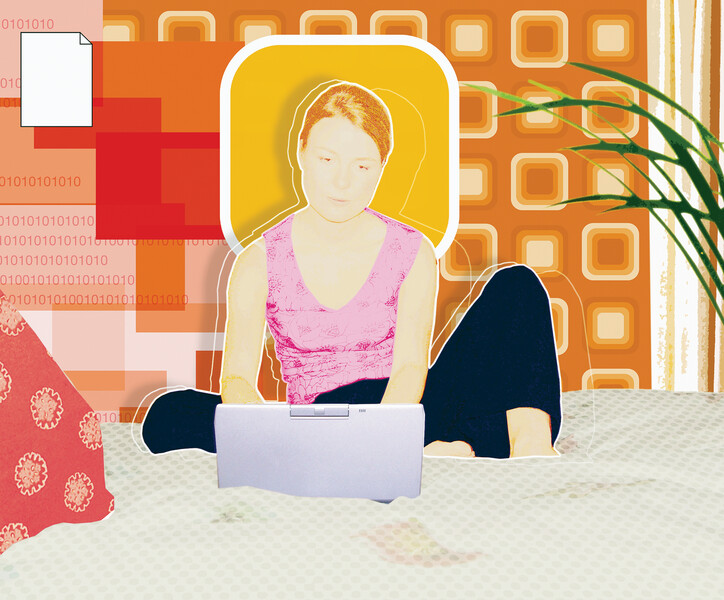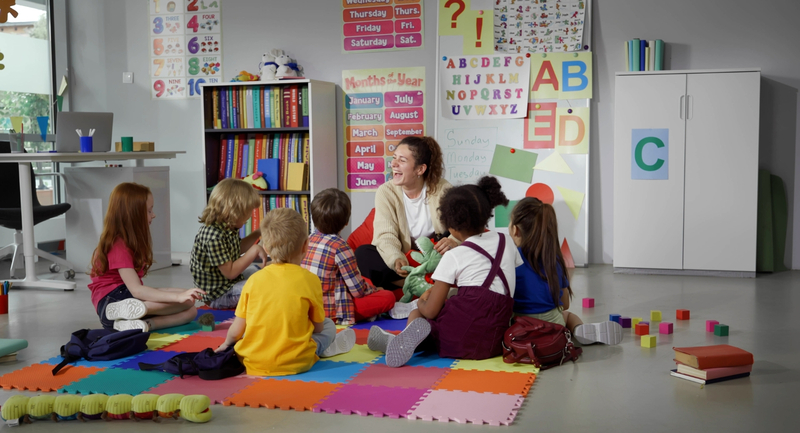Eight-year-old Joe habitually falls asleep in Ms. Peterson's class. After witnessing this several times, Ms. Peterson asks Joe why it is happening and learns he is often awakened at night by the sounds of his mother screaming and pleading as his father, under the influence of alcohol and other drugs, strikes her repeatedly.
Twelve-year-old Kristin in Mr. Wilson's class finds it difficult to concentrate on math. Mr. Wilson asks Kristin what he can do to help. With tears in her eyes, Kristin quietly explains that last night, while her mother was out running an errand, her stepfather forced himself upon her, again, and threatened, "Tell anyone and I swear, I will kill you and your mother."
Principal Daniels receives a call on his radio as the day wraps up; the call indicates that a bus from his school has been involved in a head-on crash. The car driver who ran into the bus was killed on-site. The bus driver and several students are injured. Principal Daniels jumps in his car and immediately heads to the crash scene to help with triage and support.
The incidents described above are just three examples shared with me of the kinds of school-based trauma that education leaders, as helping professionals and first responders, encounter every day. And as these leaders have experienced, daily exposure to such trauma comes at a cost: It can result in secondary traumatic stress (STS) or, more commonly, compassion fatigue. It is essential that education leaders "seek to understand more about the effects of trauma, individual coping, and the systemic supports needed to assist educators" (Johnson, 2016) who are impacted by primary and secondary trauma.
Secondary traumatic stress is defined as the natural consequent behaviors and emotions resulting from knowledge of a traumatizing event experienced by another and from wanting to help a suffering or traumatized person (Beaton & Murphy, 1995). Compassion fatigue is the weariness that comes from caring. Charles Figley, a pioneer in STS and compassion fatigue research, reflects on the impacts of working with trauma:
We have not been directly exposed to the trauma scene, but we hear the story told with such intensity, or we hear similar stories so often, or we have the gift and curse of extreme empathy, and we suffer. We feel the feelings. We experience the fears. We dream the dreams. Eventually, we lose a certain spark of optimism, humor, and hope. We tire. We aren't sick, but we aren't ourselves. (1995b)
How do I know if I am experiencing compassion fatigue? Figley notes four criteria that contribute to compassion fatigue in helping professionals: (1) being an empathetic helper; (2) having experienced some painful or traumatic event(s) in our own lives that are unresolved, and in turn, activated by similar reports of pain or trauma in others; (3) choosing to work directly with the painful or traumatic experiences of children; and (4) taking care of others and neglecting or being unaware of our own feelings and needs (Figley, 1995a). The more of these an educator experiences, the severer the impact. Symptoms of compassion fatigue include "sleep problems, relationship difficulties, frequent irritability and moodiness, feeling overwhelmed, and depression" (Hertel & Johnson, 2020, p. 41). They also include problems with setting boundaries, struggling with naming emotions, and sadness. I've seen school leaders' symptoms run the gamut: from being unable to unplug from their phones to having trouble delegating tasks to exhibiting negative self-talk to needing to be a "fixer" of all problems.
I, too, have experienced the compassion fatigue vulnerability Figely describes. I grew up in a home deeply impacted by domestic violence, alcoholism, and addiction. At age 11, I witnessed the death of a parent. That is why I went on to become a school social worker—so that I could support the social and emotional needs of children similarly impacted by trauma. But, for the first quarter of my professional career, I had no idea how to identify and get my own needs met. I abundantly gave, gave, gave to others with no regard to myself. It wasn't until I learned about the impact of compassion fatigue that I began to understand the gravity of practicing my own self-care.
The Upside of Caring
It is important to pause here and note a few essential points. First, let's be clear that caring for others, particularly those impacted by trauma, is a very good thing. It must happen. We desperately need education leaders who are compassionate, empathetic, and willing to facilitate processes in schools that positively support students and staff who are coping with trauma. But what is not OK is when caring becomes over-caring. When we give too much of ourselves to others, we may begin to neglect our own well-being, needs, wants, and feelings. This form of caring, no matter the motivation, can be self-destructive and even reinforce patterns of self-neglect. This state of chronic self-neglect then becomes fertile ground for the exhaustion, overwhelm, and resentment that are core elements of compassion fatigue.
Second, while continuously witnessing others experiencing pain and trauma can impact us negatively, it is possible to simultaneously experience positive outcomes. One example of this is compassion satisfaction (Professional Quality of Life Measure, 2012). Compassion satisfaction means deriving pleasure from the work we do, particularly when we witness positive growth and change firsthand in the trauma survivors we support.
Post-traumatic growth, the positive change experienced as a result of a professional struggle, major life crisis, or a traumatic event (University of North Carolina, 2014), is another possible outcome. Post-traumatic growth gives education leaders a strength-based, hope-filled perspective. It manifests as positive changes in self-perception; a positive change in relationships, including increased connectedness, increased belief in oneself, and the ability to navigate future challenging circumstances; more significant appreciation for life; and belief system changes, including deepening of spiritual growth (University of North Carolina, 2014).
How Full Is Your Tank?
To be emotionally available to such experiences, we have to take care of ourselves. We must embrace the radical truth that self-care is the most potent antidote to compassion fatigue. If education leaders are committed to creating trauma-responsive education environments, self-care should become a daily habit.
A favorite metaphor of mine for illustrating the energizing power of self-care relates to the gas tank in a car. (I use a similar scenario about batteries in a cell phone.) A lot of us drive a vehicle or know someone who does. Just about all cars, even hybrids, have a gas tank—cars generally require gasoline to operate. The gas gauge on the dash helps us keep track of how much gas is in the tank. When we are fortunate enough to have the resources to fill our tank (rather than just a few dollars' worth at a time), we have the freedom to go for hours without stopping to refuel. Eventually, though, after driving a while, we may notice that we're down to half a tank. After going a bit further, we may find just a quarter tank left.
Now, it has been my experience, when sharing this scenario as a trainer on professional wellness and trauma-responsive practice, that there are generally two responses from the audience about what to do next. Some say they'll begin looking for the nearest gas station to fill up. Others say they'll simply keep driving along with no worries and wait until the warning light comes on to tell them they can go a few final miles before the car runs out of gas.
What does the level of gas in a car's tank have to do with combatting compassion fatigue? Think of it this way: Each action we intentionally engage in, every day, to care for ourselves adds fuel to our overall wellness and energy levels. The more self-care we engage in, the more energy we put in our gas tank. The opposite, however, is also true. Inadequate or nonexistent self-care results in having less gas in your tank. The longer we wait to intervene, the higher the risk of professional burnout. Thus, the questions we must consider when reflecting on our levels of wellness include: How much self-care related gasoline is in my tank right now? Am I close to a full tank? A half tank? A quarter tank? Is the warning light telling me it's time to stop and fill up soon? Or am I running on fumes?
Six Categories of Self-Care
Research shows that "vicarious (secondary) trauma, compassion fatigue, and burnout can be prevented" (Wolpow, Johnson, Hertel, & Kincaid, 2011). A practical way to begin is to create a personalized self-care plan. Ensure that it includes all six categories of self-care that build on individual strengths and behaviors (Wolpow et al., 2011). Working definitions of the six self-care categories and corresponding examples include:
Physical self-care: The things I do to improve my body in healthy ways. Examples include sleep, nutrition, exercise, and health care visits.
Emotional self-care: The things I do to deal with my feelings in healthy ways. Examples include talking about feelings, creating a positive support system, seeking counseling or therapy as needed, and journaling.
Social self-care: The things I do with others and the world around me. Examples include interacting with friends and family members who energize and support us, playing, having fun, celebrating milestones and successes, and belonging to groups and communities.
Cognitive self-care: The things I do to improve my mind and understand myself better. Examples include reading for pleasure and for work, writing, continuing education, and learning something new.
Financial self-care: The things I do to stay financially responsible. Examples include responsibly spending and saving money, balancing my bank account, initiating or updating a will, and establishing plans for the future.
Spiritual self-care: The things I do to gain perspective on my life. Examples include prayer, meditation, contact with nature, attending a house of worship, and practicing the 12 Steps commonly associated with Alcoholics Anonymous.
It is essential for education leaders to dedicate time each day to self-care. Indeed, on some of our busiest workdays, this investment may only last a few moments. These short pauses, however, permit us to take a much-needed break, to breathe deeply, drink some water, eat something, or visit the restroom. (Those who are veterans in K–12 education know precisely why I included this last example!) There are also times when we need to carve out a few hours or sometimes even a day or more to rejuvenate. Examples include establishing boundaries around email (for instance, no email during the weekday after 6:00 p.m.); changing scenery or taking a desperately needed vacation; and carving out time for neglected well-being appointments.
"Protect your own wholeness so you can help others," a high school principal once told me, after experiencing a high level of compassion fatigue following a school shooting. Of course, he's right. You cannot be at your best at work or home if self-care and wellness are not a priority.
Wellness Maintenance
In addition to developing a foundational self-care plan, here are a few strategies I share when training educators on the topic of professional wellness:
Assess your level of compassion fatigue. You can find several quantitative measurement tools available online to assess levels of compassion fatigue. The Professional Quality of Life Measure is perhaps the most well-known. This self-assessment tool, available in a variety of languages, contains 30 questions designed to measure the negative and positive effects professionals experience when helping others. The ProQol subscales measure levels of compassion fatigue, compassion satisfaction, and burnout. For more information, visit the website. Commit to fostering your own resilience. Resilience is the ability to bounce back from challenge despite adversity (Hertel & Johnson, 2020). Daily and intentional practice of self-care in the six aforementioned areas fosters resilience and provides the stamina education leaders need to combat compassion fatigue. Self-care fills our professional gas tanks, recharges our batteries, and helps us navigate the ups and downs inherent in trauma-responsive work.
Practice self-awareness and self-management. Self-awareness is the ability to reflect and accurately recognize one's behaviors, emotions, thoughts, and values. Self-management is the ability to navigate stress, manage challenges, control impulses, set boundaries, and motivate ourselves in intrinsic and extrinsic ways (CASEL, 2020). It is vital, as helping professionals, to grow these social-emotional skills by intentionally seeking out training and engaging in learning communities that discuss these issues. The practices of self-awareness and self-management remind us when we need to take action—and take care—not to run out of gas.
Tap into supportive relationships. Education leaders must create safe spaces to engage in healthy, courageous conversations with those they trust. "Trust is the stacking and layering of small moments and reciprocal vulnerability over time," writes Brené Brown (2018, p. 34). In my own district, leaders regularly gather to engage in honest, authentic dialogue about our experiences working with students (and staff) affected by trauma. The simple act of sharing and listening to our colleagues is therapeutic and builds a community of trust. When we meet, we not only share stories, but we collaborate to develop compassionate, effective strategies for school-based intervention and support.
Remember to breathe. Finally, a reminder about the healing power of breath: breathing is one of the most fundamental things we do. But because it is autonomic, we can take it for granted. When done intentionally, though, breathing can be an essential self-care practice that benefits our physical health and emotional well-being. One of my favorite breathing activities is a simple four count: Breathe in … one … two … three … four. Hold for a few seconds and then repeat the process breathing out … one … two … three … four. Education leaders dealing with compassion fatigue can benefit significantly by intentionally slowing down and taking multiple deep breaths. Breathing is your greatest friend. It's been said, "Return to it in all your troubles, and you will find comfort and guidance" (Habits for Wellbeing, para. 4, 2013).
Stronger for Our Students
Remember, "we can only give to others the depths of positivity and wellness we have obtained ourselves" (Hertel & Johnson, 2020, p. 43). The benefits of self-care include reduced stress and overall distress, improved performance, and stronger relationships. I have even observed committed educators outwardly display a happy and positive heart and a brighter overall disposition.
It is inevitable, as education leaders, that we will encounter students and staff struggling with trauma. To combat the weariness that comes from caring, we must prioritize professional self-care practices. Doing so will give us the "gas" to build resilience in ourselves and effectively support those who need us most.
Author's note: All names mentioned in examples are pseudonyms.
Reflect & Discuss
➛ Think about a time when you experienced compassion fatigue. What were the symptoms? How did it impact your work?
➛ Do you think it is possible to feel "compassion satisfaction" from witnessing growth in the trauma survivors you support?
➛ Johnson suggests mapping out a personal "self-care plan" that addresses six categories of self-care. Complete this exercise and note which categories need the most attention.









